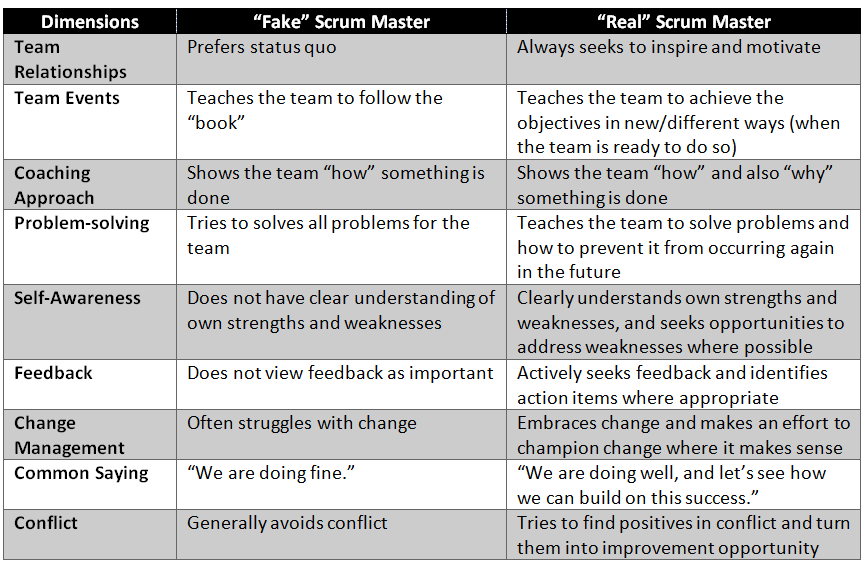How Do You Identify (And Avoid) Fake Scrum Masters?
After working with dozens of teams over the past few years, I have trained and mentored many Scrum Masters that come from a variety of backgrounds, with varying degrees of success, as you might expect. These include individuals who may have assumed this role after serving in other professional positions in the past, including (but not limited to) engineers, testers, project managers, business analysts, etc.
My experience working with different people with different personalities and domain expertise has led me believe that there are generally two types of Scrum Masters: “real“ (or aspiring) Scrum Masters and “fake” Scrum Masters. The difference between the two types of people can often be very subtle and difficult to distinguish; especially to those who are either farther removed from the teams, or are new to Scrum/Agile practices.
I have learned that many professionals choose to become a Scrum Master because they enjoy the satisfaction of the collaborative nature of the Agile team, and the ability to deliver working products/solutions on a relatively consistent basis. Being a part of a team that is able to produce tangible, working solution, and having the opportunity to get regular feedback creates a dynamic that can be very satisfying. However, at times, some individuals are placed into this role simply because there is no one else available; often times, organizations that are in the midst of adopting Scrum may choose to place a Project Manager, Engineering Manager, or another management-type in this role. While this situation does is not necessarily guarantee failure, it can often create challenges that the team must address.
Aside from understanding how to tactically practice Scrum and show others how to follow the events in a formulaic fashion, a true Scrum Master goes above and beyond the fundamentals, not because they have to, but because they want to, on their own accord. When an individual is able to embrace the Agile mindset, continuous learning, and possesses inherent curiosity for improvements of all kinds, this individual is considered a true Scrum Master. A true Scrum Master operates within the “Ri” dimension of the “Sh-Ha-Ri” model; he/she is able to organically understand the needs of the team and the organization, and anticipate process improvement changes that will reap meaningful rewards.
Whether intentional or not, a fake Scrum Master often lurks in the shadows, and mimics a Scrum Master extremely effectively. This person understands how to implement Scrum and has achieved a fair amount of success doing so, but has become complacent. He/she does the minimum to ensure the team continues moving forward, but does not make an effort to inspire the team to move past the “Ha” stage of “Sh-Ha-Ri”. The Scrum Administrator can often cause more harm than realized over time due to stagnation of the team. This is difficult to see, but there comes a point when a team has reached a plateau, and is no longer motivated to improve in some way. One technique for identifying this condition is the Retrospectives. Teams that have been together for several months/sprints can fall into the trap of “we don’t need the Retrospectives anymore; we know how this works and we are doing just fine”. This behavior and mindset is often a symptom of the individual no longer motivated to keep things fresh and challenge the status quo.
Change is difficult, and requires a lot of effort, energy, and sometimes frustration. As human beings, our default mode of operation is safety – keeping things as predictable as possible so we feel secure and not threatened by the unknown. Hence, it is understandable for organizations that had top-notch Scrum teams with highly-motivated Scrum Masters to devolve into a state of complacency. So how do teams and organizations prevent this scenario? What can be done to address this phenomenon?
Building and sustaining self-motivated teams is a difficult task, especially over an extended period of time. The Scrum Master is at the core of a team’s mindset and behavior, which means this person is expected to play a big role in guiding the team and challenging them to elevate their performance as a cohesive unit, and somehow inspire them to strive for higher performance.
The table below outlines a few characteristics of a “real” versus “fake” Scrum Masters based on my personal experience. I acknowledge that this will likely be very subjective and open to debate.
Based on the points I shared above, it makes sense for us want to avoid “fake“ Scrum Masters. In the perfect world, naturally we will prefer “real“ Scrum Masters, but they are difficult to find, simply because it requires tremendous amount of investment to sustain over a long period of time. The important thing is for us to recognize that some Scrum Masters may begin in the “fake” realm, but have the potential to evolve into a true Scrum Master with adequate coaching and guidance from someone who can offer mentorship. While some organizations may be content with less-than-perfect Scrum Masters, it is my opinion that all teams should aspire to develop true Scrum Masters because it optimizes the long-term productivity and sustainability of the team, as well as providing an environment for growth of the Agile practice. If you are satisfied with the level of performance of your teams, you may not need to change that; just recognize this and set your expectations accordingly. However, if you wish to achieve more than what your teams have been able to produce, it may make sense to challenge your teams to evaluate where they are today, and where they feel they need/want to be in the future.




